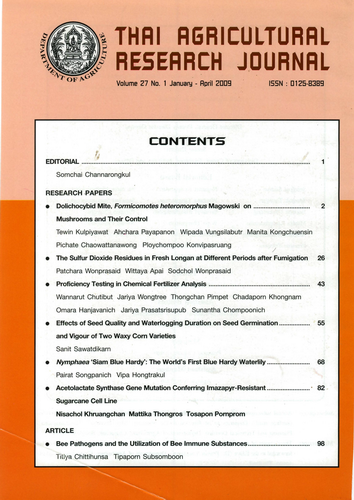Acetolactate Synthase Gene Mutation Conferring lmazapyr-Resistant Sugarcane Cell Line
DOI:
https://doi.org/10.14456/thaidoa-agres.2009.6Keywords:
acetolactate synthase , ALS, imazapyr-resistant sugarcane cell line, less sensitivity , point mutation, sugarcaneAbstract
Selection of sugarcane cell line resistant to imazapyr was conducted to investigate whether the biochemical and molecular basis of resistance was acetolactate synthase (ALS) gene mutation in resistant sugarcane cells. The experiment was conducted at the Laboratory of Plant Research Group, National Centre for Genetic Engineering and Biotechnology, Kasetsart University, Kamphaeng Saen Campus, Nakhon Pathom province. Selection of sugarcane cells resistant to imazapyr was carried out using callus and cell suspension induced from the tight young furled leaves of sugarcane clone K 97-32. The cell suspension was cultured in modified liquid MS medium supplemented with coconut water 10%/L, casein hydrolysate 0.5 g/l, myo-inositol 0.1 g/l and 2,4-D 3mg/l. A sugarcane cell resistant to 1µM imazapyr was obtained after 378 days of selection, using a stepwise selection with increasing concentraltions of imazapvr from 0.1 to 1µM. Surviving cells were sub-cultured at 14 days interval. This indicates that the resistant cells was 918-fold more resistant to imazapyr than the normal cells. To establish the biochemical mechanism of resistance to imazapyr, ALS activity of the resistant cells was 10.8-fold higher than that of the normal cells. In addition, to investi-gate the molecular of ALS gene at target site responsible for the herbicide activity, the partial of ALS gene region covering 455 bp of domain B and E from the normal and resistant cells was amplified and sequenced. The partial sequence of ALS gene of the normal and resistant cells was deposited in the GenBank database with accession number EU 243998 and EU 243999, respectively. The ALS gene sequence of the resistant cells showed the point mutant a form deletion of alanine (A) at 666 position, numbering based on Arabidopsis thaliana (GenBank accession number X 51514). This result suggested that the partial of ALS gene was occurred the point mutant a form deletion resulting in the alteration at target site, based on the ALS activity, leading to less sensitivity to imazapyr.
Downloads
Published
How to Cite
Issue
Section
License
Copyright (c) 2017 วารสารวิชาการเกษตร (Thai Agricultural Research Journal)

This work is licensed under a Creative Commons Attribution-NonCommercial-NoDerivatives 4.0 International License.
Thai Agricultural Research Journal



